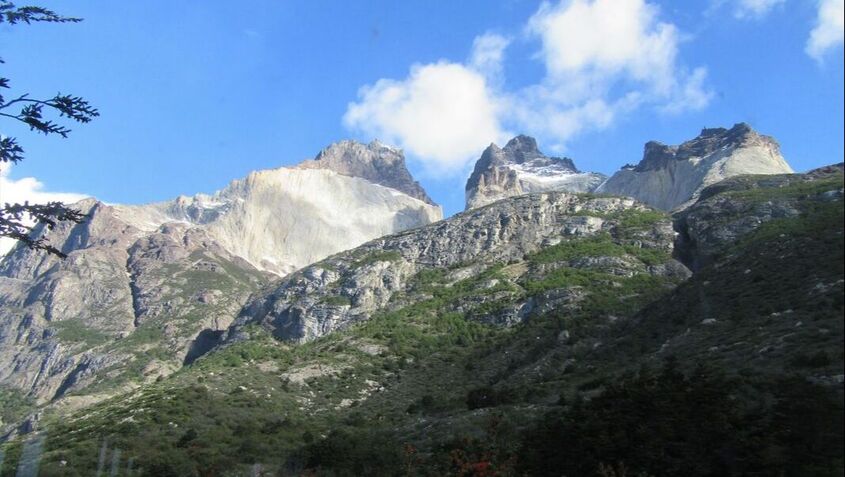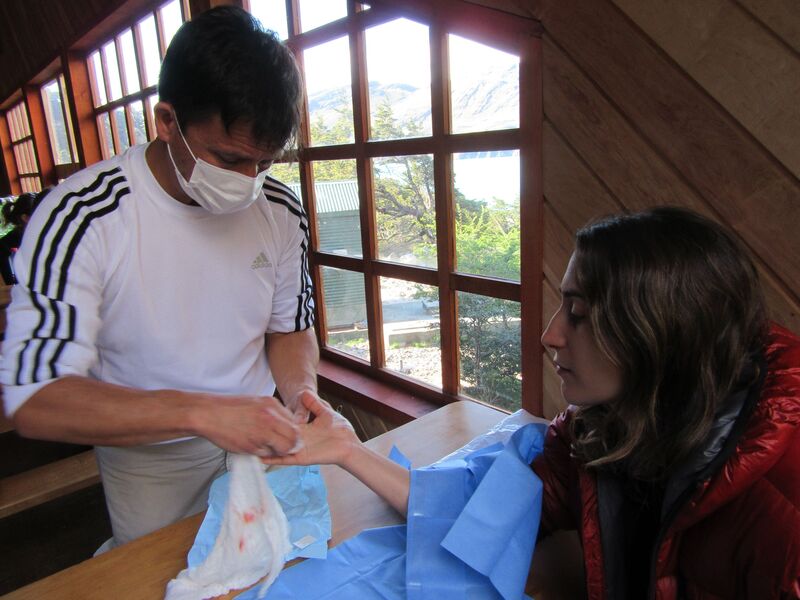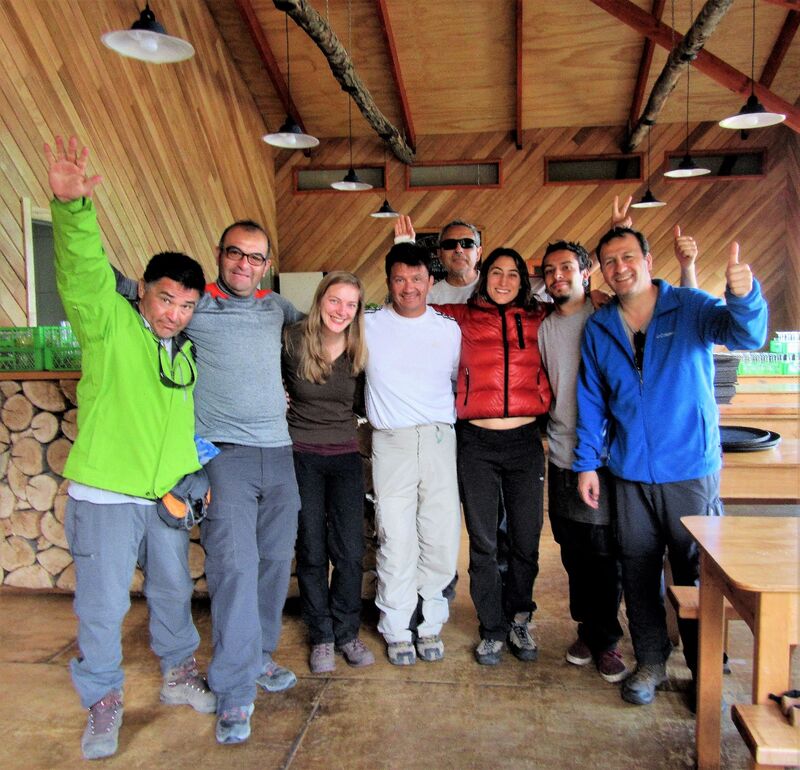|
“Welcome to Punta Arenas,” the guesthouse owner exclaims as she greets Nicole and I with a hug and a kiss. As a western European for whom physical contact is reserved for special occasions, Chileans’ expressions of hospitality through touch still catch me off guard. I used to think my culture’s social reservedness could be blamed on the weather, but the calor Patagonians radiate so close to the South Pole once and for all puts that theory to bed. After a stroll through Punta Arenas, we catch the bus to Puerto Natales, where we trim the content of our backpacks until the scale reflects the desired numbers. Do we have enough food on us? Will we be cold at night? Will the wind knock us off our feet? We will find out soon enough. A slap of wind in the faceIn the morning, we make our way to Torres del Paine, Patagonia’s most famous national park. The bus drops us off at Pudeto, from where our journey continues by catamaran to Paine Grande. Hiking the eleven kilometres to Lago Grey had sounded like an easy feat, but the wind soon humbles us and turns every step forward into a personal victory. My sunglasses are whisked away, but spotting the first blocks of ice floating on Lago Grey makes the battle worthwhile. The night is short. I shiver in my embarrassingly thin sleeping bag, while I listen to the soundtrack of ice chunks breaking free from the glacier and plunging into the lake. In the morning, we get to see the spectacle with our own eyes. The light reflecting off its ice fields gives Grey Glacier a blue appearance. When our limbs start to feel numb, we retrace our steps and head back to Paine Grande. Clenching my bottle filled with boiling water between my grateful toes, I doze off comfortably. Around 3 AM the wind sends us a wake-up call. Something feels different. But what is it? Our tent stakes are still in place. Then what feels off? One look at the roof provides the answer: a metal tube connecting our tent pole has snapped under the pressure of the wind, slashing through the outer sail, with the pole now pointing straight up to the stars. A starry, starry nightResponding with a thick layer of duct tape in the morning, we head towards Los Cuernos with our fingers crossed, taking in lovely views of the lake as we slowly walk uphill. After carefully inspecting several sites at Los Cuernos, we pitch our tent close to the rock in a shielded area, or so we think. Tonight will be the ultimate test for our improvised roof before we hike up to Campamento Torres. The exhaustion kicks in and I sleep like a baby. Until 4 AM, that is, when a particularly loud blow forces me to open my eyes and I find myself staring at a beautiful, starry sky. Our tent sail is gone with the wind. As I rush out in search of the missing piece of fabric, Nicole attempts to reassemble the tent poles that have once again come undone. “I refuse to risk my life out here,” our neighbour shouts as he sprints past, clinging on to his collapsed shelter. “I am going to sleep on the floor of the refugio.” I finally locate the sail and start heading back when I hear Nicole scream. The broken metal tube has gashed her hand. As she runs off to the refugio, I stand next to the remnants of our tent, dazed and confused. Do I stay behind to keep the rest of our stuff from blowing away? No, I need to make sure Nicole is alright. A trail of blood drops guides the way. It is worse than I thought. When I walk in, our neighbour is already helping Nicole clean out the wound, but her pale face tells me she isn’t well, so I knock on every door until a staff member with a first aid kit is found. “Yes, the wind can be very strong here,” he confirms matter-of-factly as he administers a bandaid. “Last month, it blew over a tour bus.” We spend what’s left of the night on our mats in a shed next to the refugio. Sleep remains nothing more than wishful thinking, however, as I can’t help but check whether the corrugated roof is still in place with every gust of wind traveling from the lake to the mountain and back. Surgery for breakfastAfter breakfast, Nicole still feels nauseous and weak. In the middle of a national park without road access, our options are limited, so we decide to hope for the best. When we are ready to set off, a fellow hiker suggests that the doctor who stayed at the refugio last night could take a quick look. The idea of peeling off the bandaid again doesn’t immediately excite Nicole, but she accepts the offer. “Yep, you need stitches right now. If you go out with a wound that deep, it will get infected in no time and you might even lose your hand.” Wait, what? “Don’t worry, I’m a traumatologist.” Before we have even begun to digest his words, a full-blown surgery kit is pulled out from his backpack. The breakfast table is transformed into an emergency room: blue cloth, mouth mask, headlamp, anesthesia, needle and stitches. I hold Nicole’s hand and in a pathetic attempt to distract her, I casually comment on how gorgeous the mountains look. A little loopy from the anesthesia, she is having none of it: “Doctor, you’re hurting me! Doctor, are you sure you’re a real doctor? Don’t put this on YouTube!” We hit the trail an hour later, good as new thanks to the swift intervention of our new best friend. Our initial plan of climbing up to Campamento Torres to admire the park’s iconic torres at sunrise is officially off the table. Instead, we head for the much less inspiring Camping Central down in the valley, where we rent a sturdier tent for the night. We drop off our bags and in a desperate move to still catch a glimpse of the torres, we stubbornly start our ascent, foolishly ignoring the thick clouds already gathering at the top of the mountain. After two hours of climbing, the rain and mist serve us another lesson in humility. No tent, no view, and no dry clothes. We laugh off our pitiful attempt with a warm drink before heading back down. No pain, no fameAt night, someone knocks on our tent sail. “Is Nicole here? The staff at Los Cuernos let us know you were coming. There’s a hotel down the road where they can take a look at your hand.” With nothing better to do, we might as well.
“Hola, the girl from the campsite sent me here,” Nicole explains to the receptionist, whose eyes instantly light up: “You’re Nicole!” How she gained celebrity status overnight becomes clear when he turns his computer screen our way and shows us the surgery photos circulating on the staff's group chat. Even in a national park with hardly any phone connection, word travels fast. In the morning, we indulge in our cappuccinos while waiting for the bus to take us back to Puerto Natales. We may not have seen the torres del paine, but leave the park having learnt an important lesson: camping in winds of 100km/hour might not be the best idea after all. |









 RSS Feed
RSS Feed
